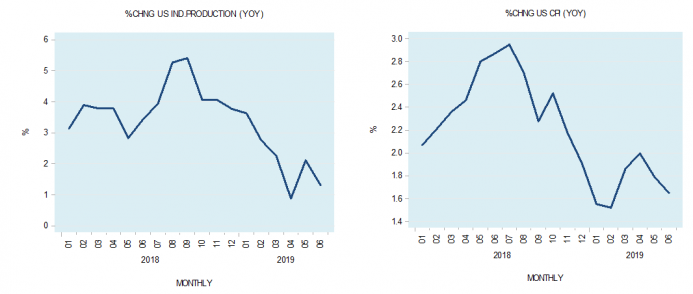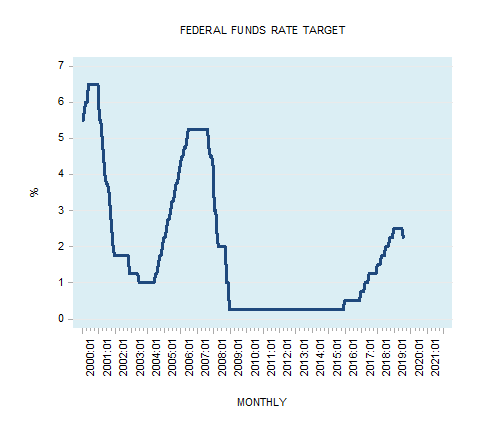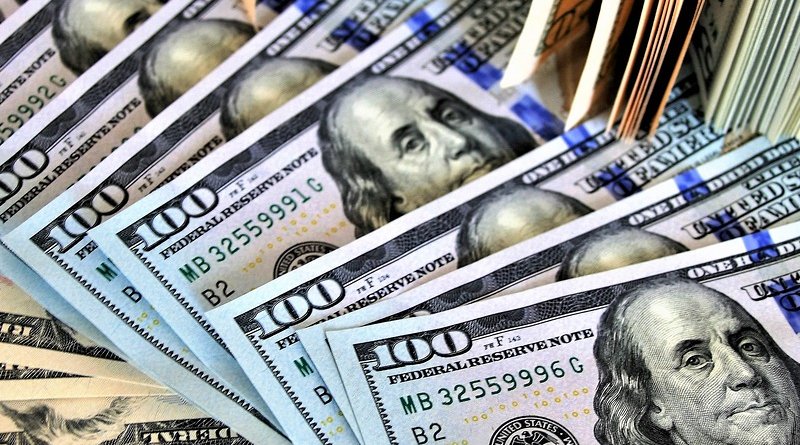Money Printing Can’t Replace Saving And Production As The Real Engine Of Economic Growth – Analysis
By MISES
By Frank Shostak*
There are some signs that the pace of US economic activity is starting to slow down. For instance, the yearly growth rate of industrial production, which closed at 5.4% in September 2018, fell to 1.3% by June this year (see chart).
In addition, the annual growth rate of the consumer price index (CPI) eased from 2.9% in July last year to 1.6% by June this year (see chart).

Once economic activity indicators begin to display softening, policymakers at the Federal Reserve begin to show their eagerness to prevent the economy from falling into a recessionary hole by softening their monetary stance. In response to the recent weakening in economic data, policymakers have lowered the federal funds rate target at the end of July by 0.25% to 2% (see chart).

By the popular way of thinking, the lowering of the interest rate is likely to strengthen the overall demand for goods and services and this in turn is going to strengthen the production of goods and services (i.e., going to strengthen economic growth). Note that a decline in economic activity, according to this way of thinking, is a result of a weakening in the overall demand. Once demand is given the necessary boost, the economic growth should follow suit.
To Strengthen Demand, Strengthening Supply
Observe that individuals are engaged in the production of goods in order to maintain their life and well-being. The fact that each individual is likely to have difficulty to produce all the goods they require to maintain their life and well-being provides the impetus for trade.
By means of trade, individuals can exchange goods that they have produced for goods produced by other individuals. For instance, John the baker not only produces bread to accommodate his personal requirements with respect to bread, but he also produces bread in order to be able to exchange it for other goods and services.
The ability to trade permits each individual to focus on the production of goods and services that they are best at, enabling individuals to specialize.
John the baker can exercise his demand for various goods such as shoes and fruits, by exchanging for them loaves of bread that he has produced. Through the increase in the supply of bread, John can also increase his demand for other goods. Note that his demand for goods is imbedded in his production of bread, i.e., his supply of bread. Also, note that his demand is constrained by the production, i.e., by the supply of bread. The greater the production, i.e., his supply of bread is the more goods and services John could acquire.
However, it is not enough for producers to offer a supply of goods, there must also be a market for their products. We can thus deduce that an individual must produce something useful to other individuals in order to secure for himself goods that are going to support his life and well-being.
We can also infer that through trade individuals, exchange something for something else. The exchange of something for something means that individuals are paying for the goods with goods.
Money Cannot Replace the Need for the Production of Goods
The introduction of money does not alter the essence of the above. Money is just the medium of the exchange. Money makes it possible to expand the trade among various individuals. The introduction of money does not alter the fact that individuals still have to produce something useful in order to secure some other useful goods for themselves.
The introduction of money makes the emergence of various trades possible. For instance, rather than trying to exchange directly meat with a vegetarian producer of apples the butcher can now secure apples not through a direct exchange but through indirect exchange. The butcher could exchange his meat for some other more accepted commodity such as gold and then exchange gold for apples. (The more accepted commodity we label as money.)
Note that an individual exchanges something for money and then exchanges money for something else. This means that money serves as a facilitator it enables the exchange of something for something. By itself, however money does not produce anything — it is just the medium of the exchange. According to Rothbard in Man, Economy, and State,
Money, per se, cannot be consumed and cannot be used directly as a producers’ good in the productive process. Money per se is therefore unproductive; it is dead stock and produces nothing.
Note again, that money does not replace the need to produce goods and services. The role of money is to facilitate trade through the replacement of a direct exchange by an indirect exchange. This means that contrary to popular thinking in the money economy individuals pay for goods by means of other goods and not with money, which only provides the services of the medium of the exchange. Again, money is not the means of payment but just the medium of the exchange. Payment is always done by means of goods and services.
Counterfeiter Effect and Monetary Growth
Now, consider the case of a counterfeiter that generates faked money that masquerades as proper money. The counterfeiter uses the forged money to exchange it for goods and services. What we have here is an exchange of nothing for money and then the exchange of money for something, i.e., we have here an exchange of nothing for something. (Note that the counterfeiter did not produce any useful goods hence why nothing is exchanged for money.)
We suggest that in the present fiat system an expansion in the money supply always leads to an exchange of nothing for something or to the counterfeiter effect. Whenever the central bank through easy monetary policy makes it possible for the increase in the money stock, it permits the expansion of money out of “thin air.” This in turn sets in motion the process of the exchange of nothing for something.
The early receivers of the newly generated money are in the same position as the counterfeiter. The early receivers of money are getting wealthier since they now have more money than before the increase took place. The early receivers can now acquire a greater amount of goods while the prices of goods are still unchanged. The last receivers of money or the non-receivers of money are going to endure the burden of price increases and a decline in their living standards.
Idle Resources Emerge Because of Previous Boom
What those commentators who advocate monetary pumping to absorb idle resources have overlooked is the fact that these resources have become idle on account of the previous boom brought about by the previous loose monetary policy of the central bank. Because of the previous loose monetary stance various non-productive or “bubble” activities, have emerged. These activities depend on the loose monetary policy for their existence, which diverts to them real wealth from wealth generators.
A tighter stance of the central bank stops this diversion, thereby reducing the number of bubble activities and ultimately strengthens the process of wealth generation. The damage, however, that was done by the previous loose monetary policy cannot be undone in the short term. Once, the process of wealth generation gains momentum the expansion in the pool of real wealth makes it possible for the absorption of various idle resources. According to Mises in Human Action,
Out of the collapse of the boom there is only one way back to a state of affairs in which progressive accumulation of capital safeguards a steady improvement of material well-being: new saving must accumulate the capital goods needed for a harmonious equipment of all branches of production with the capital required. One must provide the capital goods lacking in those branches which were unduly neglected in the boom. Wage rates must drop; people must restrict their consumption temporarily until the capital wasted by malinvestment is restored. Those who dislike these hardships of the readjustment period must abstain in time from credit expansion.
Furthermore says Mises,
If commodities cannot be sold and workers cannot find jobs, the reason can only be that the prices and wages asked are too high. He who wants to sell his inventories or his capacity to work must reduce his demand until he finds a buyer. Such is the law of the market. Such is the device by means of which the market directs every individual’s activities into those lines in which they can best contribute to the satisfaction of the wants of the consumers.
Because of a recession according to experts, resources that can be utilized in normal times to promote economic prosperity are now made underutilized. Hence, it is held the strengthening of the demand will not only strengthen the economic growth but it will also prevent the emergence of idle resources. On this Ludwig von Mises wrote,
Here, they say, are plants and farms whose capacity to produce is either not used at all or not to its full extent. Here are piles of unsalable commodities and hosts of unemployed workers. But here are also masses of people who would be lucky if they only could satisfy their wants more amply. All that is lacking is credit. Additional credit would enable the entrepreneurs to resume or to expand production. The unemployed would find jobs again and could buy the products. This reasoning seems plausible. Nonetheless it is utterly wrong.
Commentators are correct by saying that what prevents the increase in the production of goods and the absorption of idle resources is the lack of credit — there is, however, the need to emphasize that the credit that is lacking is the productive credit — the one that is fully backed by real wealth.
Briefly, productive credit emerges when a wealth generator lends some of his real wealth to another wealth generator. By giving up the use of the loaned real wealth at present, the lender is compensated in terms of the interest rate that the borrower agrees to pay. As a rule the greater the expansion in the real wealth the lower the interest rate that the lender is likely to agree to accept, i.e., his time preference is likely to decline.
From this one can deduce that interest is just an indicator as it were — it is not responsible for the expansion in real wealth. Consequently, any policy that tampers with interest rates makes it much harder for wealth generators to assess the true state of the productive credit. This in turn leads to the misallocation of productive credit and to the weakening in the wealth generation process. Because of distorted interest rates an overproduction of some goods and under production of other goods emerges.
Bubbles, booms, and eventual crashes result.
*About the author: Frank Shostak‘s consulting firm, Applied Austrian School Economics, provides in-depth assessments of financial markets and global economies. Contact: email.
Source: This article was published by the MISES Institute


Hayek, Mises, and all monetary economists had ignored a major factor in theorizing and talking about nonetary theory and the role of money. That factor was Trump. All those economists did not predict that a smart politician could out-smart all of them in one statement at the White House. Trump’s monetary statements do not need need evidence and proof because no one has been every created to know Trump’s monetary theories. Trump’s thinking is way above human mentality and no one can understand but the creator.
I feel so sorry about the Austrians when they missed the Trump’s phenomenon.
Money Printing Can’t Replace Saving And Production As The Real Engine Of Economic Growth
Especially when that printed money goes just to the banksters